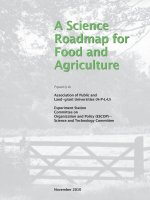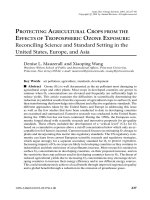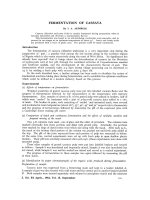Issue journal of the science of food and agriculture( fermentation of cassava)
Bạn đang xem bản rút gọn của tài liệu. Xem và tải ngay bản đầy đủ của tài liệu tại đây (396.2 KB, 6 trang )
FERMENTATION
OF
CASSAVA
By
I.
A. AKINRELE
Cassava
(Manzhot
utzlzsszma
Pohl) is usually fermented during preparation when
it
This fermentation was found to be self-sterilising, exothermic and anaerobic, and to
Lactic and formic acids
becomes detoxified and develops
a
characteristic flavour.
proceed in two stages at an optimum temperature
of
about
35".
are produced with
a
trace of gallic acid. The process could be made continuous.
Introduction
The fermentation of cassava
(Manihot utilissima)
is a very important step during the
preparation of
'
gari
',
a popular food among the low income group in the southern regions
of Nigeria which is also eaten extensively along the coast of West Africa. Its significance has
already been reported1 that it brings about the detoxification
of
cassava by the liberation
of hydrocyanic acid at low
pH,
through the combined activities of
Corynebacterium manilaot
and
Geotricum candida,
and the development of the characteristic flavour of gari. This
fermentation which normally takes 3-4 days during village processing can be shortened to
24 h. by seeding a fresh pulp with cassava juice
4
days old.
In the work described here, a further attempt has been made to elucidate the nature of
biochemical reactions taking place during fermentation, and to establish the optimum conditions
which could be utilised in a modern industry based on this process.
Experimental
(I)
Effects
of
temperature
on
fermentation
Weighed quantities
of
grated cassava pulp were put into labelled vacuum flasks and the
progress of fermentation followed by the measurement of the temperature with mercury
thermometers. Also, samples of about
5
lb. of the grated pulp were placed in beakers, half of
which were
'
seeded
'
by treatment with
I
pint of 3-days-old cassava juice added to
I
cwt.
of mash. The beakers in pairs, each consisting of
'
seeded
'
and untreated mash, were covered
and incubated at room temperature (about
26"),
35",
40°,
45" and
50"
respectively in thermostats
and the progress of fermentation followed by measuring the
pH
of the expressed juice with
a Cambridge direct reading
pH
meter.
(2)
Comparison
of
batch and continuous fermentation and the effects
of
sunlight, aeration and
Two
3-ft.
columns were used-one
of
glass and the other of porcelain. The columns were
marked externally into three portions and filled with grated pulp. Internally, the portions
were marked by rings of dyed cotton wool which slid along with the mash. After each 24 h.,
the mash at the bottom third portion of the column was pushed out and fresh pulp added at
the top. The
pH
of the juice expressed from each portion of pulp was measured as before.
At the same time, control experiments were set up with fresh pulp in open shallow plastic
buckets. Their pH were similarly measured after each 24 h. (these experiments were done with
unseeded pulp).
Three other samples of grated cassava pulp were put into labelled beakers and treated
as follows
:
Sample
S
was inoculated and frequently mixed, Sample A was also inoculated but
not mixed, while Sample
C
was neither seeded nor mixed and served as a control experiment.
The progress of fermentation in these samples was again followed by measuring the pH
of their juices.
(3)
Identijcation by paper chromatography
of
the organic acids produced during fermentation
Preparation
of
sample
Cassava juice was expressed from a fermenting mash and kept in a beaker labelled A.
A sample of gari was also treated with cold water and the extract put in another beaker labelled
B. Both samples were treated separately with ethanol to precipitate starch and the mixtures
frequent mixing
of
the mash
J.
Sci.
Fd
Agric.,
1964,
Vol.
15,
September
00
590
AKINRELE-FERMENTATION OF
CASSAVA
were filtered. Each filtrate was then passed through Amberlite resin
IRA-400
in the carbonate
form in order to absorb the organic acids,2 and subsequently eluted with O*IN-ammOniUm
carbonate. The excess of ammonium carbonate was decomposed by heat during concentration.
Alphatic
acids3
Solutions from these samples were spotted with micro-pipettes on to Whatman
No.
I
papers with other spots of the following reference acids
:
orthophosphoric, lactic, succinic,
oxalic and tartaric. Duplicate papers were prepared, one paper was developed with mesityl
oxide-85% formic acid-water
(75
25
:
I)
and the other with phenol-water-formic acid
(75
:
25
:
I)
using descending chromatography. The chromatograms were dried, sprayed with
bromocresol green indicator
(0.04
g.
in
15
ml. of ethanol
+
5
ml. of water, pH adjusted to
5.5)
and the
R,
values measured.
Aromatic acids
Sample solutions prepared as above were spotted on two Whatman
No.
I
papers and
developed with butanol-acetic acid-water
(4
:
I
:
5)
by descending chromatography. Reference
standards were chosen from the following phenolic compounds,
viz.,
vanillin, pyrocatechol,
pyrogallol, P-hydroxybenzoic acid, gallic acid, hydroquinone, salicylic acid and phloroglucinol.
One chromatogram was sprayed with ferric chloride and the other with ammoniacal silver nitrate
and the
RF
values measured.
Volatile acids4
Another portion of the juice expressed from a fermenting cassava mash, which should
contain all the volatile acids, was treated with alcohol to precipitate starch and then filtered.
The filtrate was neutralised with o.og~-bariurn hydroxide (phenolphthalein indicator) and centri-
fuged. The supernatant solution was decanted and evaporated almost to dryness. Excess
of saturated ammonium oxalate solution (about 5 ml.) was added and the whole mixed and
filtered. The filtrate which contained the ammonium salts of the volatile acids was used for
the chromatographic examination. This solution was next spotted on two Whatman
No.
I
papers and developed with butanol-~.g~-aq. ammonia
(50
:
50). Reference spots were made
with formic, acetic, propionic, butyric and lactic acids which had been made alkaline with
ammonia. The chromatograms were dried and one was sprayed with Bromocresol green and
the other with ammoniacal silver nitrate to distinguish between acetic and formic acids. The
Rp
values of the developed spots were then measured.
Results
The increases in temperature accompanying fermentation in the vacuum flasks are typified
by curves shown in Fig.
I
for two series of results.
The pH readings taken to compare batch and continuous fermentation and also the effects
of sunlight and exposure to air are recorded in Table
I.
The effect of the frequent mixing
of the mash on the progress of fermentation, measured by the fall of pH with time, is shown
0
20
40
60
80
TIME,
h.
0
FIG.
I Temperature
rise
during
fermentation
of
cassava
pulp
(two
sets
of
results)
J.
Sci.
Fd
Agric.,
1964,
Vol.
15,
September
AKINRELE-FERMENTATION OF CASSAVA
591
Table
I
pH
readtngs durzng batch and contznuous fermentatzon of cassava mash
Batch fermentation in open buckets
Continuous fermentation in tubes
Control (exposed to light)
Glass
Porcelain
Sample
24
h.
48
h.
72
h.
96
h.
24
h.
48
h.
72
h.
96
h.
24
h.
48
h.
72
h.
96h.
-_
4.20 3.85 3.85
-
4.1 4.05 4.0
4.0 4.0j 4.1
-
A
H
4.25 4.3 4.3
4.2 4.0 4.1
c
4'35 4'3 4'3 4.2 4.1 4.05
4.2 4.1 4.1
-
E
4.j 4.3 4.1
-
4.r.j 4.1 4.0
-
4.1 4.2 4.15
-
-
4'25 3'9 3'9
-
D
4.2 4.2 4.25
4-25 4.2 4.1
-
4'2
4.15 4'15
-
1;
4'3 4.15
-
4.15 4.2 4.0
-
4'1 4.2 4.0
-
4'0
G
4.25
-
4.1 3.8 4.15
-
4'0 3'7 4'1 4'1 3'7
4'2 3-9 3'9
Average
4.3~ 4.26 4.12 3.97 4.19 4.11 3.98 3.86 4-13 4.11 4-08
3.9
in Table
I1
;
whilst Fig.
z
shows the relationship between the rate of fall of
pH
and time at
45".
The effect of incubating the mash at various temperatures is shown in Fig.
3.
The
RB.
values obtained during the chromatographic separation of the organic acids
of
cassava mash and gari are recorded in Tables
111-V.
Passage of the
gas
evolved during fer-
mentation through lime water produced a turbidity, but the remaining gas was not absorbed
by
40%
sodium hydroxide solution.
It
is
inferred that the formic acid present
is
decomposed
to carbon dioxide and probably hydrogen.
-
4.15 3.8
3.8
-
4'3 3'9 4'05
-
H
Table
I1
PH
of fermenting cassava mash at various times
Incubated
at
4j0
__
Time, Incubated
at
35'
h.
S
A
C
S
A
c
0
2
4
7
I1
12
I4
16
I8
20
22
2
5
28
30
5'90
5.60
5'51
5'05
4'25
4.05
3'94
3'83
3'70
3.67
3'67
3.62
3'45
3'44
5'90
5'58
5.50
5.06
4.46
4'24
4.02
3.88
345
3'72
3.69
3.66
3'51
3'49
5.90
5'74
5.50
5.38
4'63
4'30
4'22
4.12
4'0
4'0
4'0
3'94
3.78
3.78
5.93
5'75
5'50
5'35
4%
4'55
4'25
4'2
4'0
3.85
3'7
3'7
3'65
-
5'93 5'93
5'70
5'75
5'46 5-65
5'05
5'55
4'95 4'95
445
4'95
4.65 4'75
4'65 4'6
4'37 4'45
4-25 4'40
4.05 4.2
3'97 4'1
4.20 4'25
- -
S
=
inoculated acid mixed frequently
,,
but not mixed
C
=
control
-
-
0.1251
I
I
TIME,
h
FIG.
2 Rate of fall
of
PH
during fermentation
of
cassava
pul9
at
45"
x
inoculated, unmixed
0
inoculated, mixed
0
uninoculated, unmixed (control)
J.
Sci.
Fd
Agric.,
1964,
Vol.
15,
September
592
AKINRELE-FERMENTATION
OF
CASSAVA
w
3
A
>
I
a
a
-0
10
20
30
TIME,
h.
FIG.
3 pH
values after
diflerent
times for fermentation of cassawa
pulp
at different
temperatwe:
(uninoculated)
0
50'
0
45'
A
40'
A
35'
X
26"
(inoculated)
0
- - -
0
Table
111
RF
Values of acids
in
fevmentang cassava mash
Developing solvent
Mesityl oxide-formic Phenol-water-formE
~
acid-water
Orthophosphoric acid
0.24
Lactic acid
0.67*
Succinic acid
0.71
Gari acid
0.62
Pulp (fermented) acid
0.61
Tartaric acid
-
Oxalic acid
0'52
acid
0.17
0.13
0.72
0.71
0.70 0.69
0.41
0.38
0.71 0.71
0.72 0.70
0.29
0.25
*
Three spots were obtained
at
RF
0.67, 081
and
0.88
Table
IV
RF
Values of aromatic acids
in
fermenting cassawa mash
(developing solvent butanol-acetic acid-water
4
:
I
:
5)
Phenols and aromatic
acids
Vanillin
Pyrocatecliol
Pyrogallol
p-Hydroxybenzoic acid
Gallic acid
Salicylic acid
Hydroquinone
Phloroglucinol
Gari acids
Pulp (fermented) acids
0.87,
0.83
0.80,
0.82
0.70, 0.71
0.84,
0.85
0.60,
0.64
0.81,
0.82
0.09,
0.66
;
0.11,
0.66
0.09,
0.65
;
0.13,
0.67
__
-_
Standard
values
0'92
0.85
0'77
0.90
0.69
0'95
0.88
0.76
-
-
Discussion
,4
very striking feature of the fermentation of cassava is the good reproducible results
obtained in various experiments in which crude culture inoculants were used.
It
would appear
that the medium is self-sterilising against adventitious infestation by undesirable micro-
organisms and that biochemical studies could be carried out satisfactorily on it.
The acceptability of gari
is
to a large extent influenced by
its
sourness and this in turn
is
directly related to the degree
of
fermentation. In Table
VI
is seen the direct relationship
of the
pH
of fermenting cassava mash to the flavour quality
of
gari prepared therefrom. The
J.
Sci.
Fd
Agric., 1964,
Vol.
15, September
AKINRELE-FERMENTATION
OF
CASSAVA
593
least acceptable flavour is found with material of pH
3.95
which is the average value obtained
in fermentation for
4
days under normal conditions
(see
Table
I).
This value can sometimes
be attained more quickly, particularly in locations where cassava processing is a regular practice.
Table
V
Rp
Values
of
volatile acids
in
feiwenting cassaua mash
(developing solvent butanol-I.5~-ammonia
50
:
50)
Acids Bromocresol Ammoniacal silver
green spray nitrate spray
Formic
0'10
+
Dark brown
Acetic
0'12
-
-
Propionic
0'2
I
Butyric 0.31
-
Lactic
0.08,
0.15
+
Yellow
Pulp
(fermented)
0.08
+
Dark brown
Table
VI
Effect
of
PH
and acidity
on
$avow quality
of
gari
pH
of
cassava mash 3'70 3.60 3.80 3.87 3.90 3'93
Total acidity
(yo
as lactic)
of gari made therefrom 0.92
I
'04
0.66
0.58
0'43 0.40
Taste and flavour Good Satisfactory Good Satisfactory Just Rather
Swelling index 4'75 4'40 4.20
4.60
5.10 4'30
satisfactory
poor
That this fermentation is accompanied by the evolution of heat
is
well established in Fig.
I.
The two peaks shown in each fermentation appear to be characteristic and coincide with the
periods
of
dominant growth of the micro-organisms isolated and identified in the cassava mash.
This would, therefore, seem to confirm the two-stage fermentation hypothesis put forward by
Collard
&
Levi.l
The results in Table
I
indicate that continuous fermentation is possible and that it is more
effective than the batch type. The process could therefore be streamlined, probably by the
use of a tunnel without a great risk of serious contamination.
The effect of sunlight (comparing the results for porcelain and glass tubes in Table
I)
also
becomes observable only after
48
h. of normal fermentation, when a differential lowering of
the pH of the mashes is indicated,
It
is significant that this period should again coincide with
the onset of the second stage of fermentation during which the fungus,
Geotricmn calzdida,
is
re-
ported to proliferate and to produce a variety of aldehydes and esters. This could mean that
light may have a stimulating effect
on
the growth of the fungus whose optimum pH for growth
is
known5 to be about
3.
Cassava pulp when exposed to air
soon
acquires a brownish discoloration from the oxidation
of its leuco-anthocyanins, viz., delphinidin and cyanidin. The deeper layers, however, which
are rendered anaerobic by the evolution of carbon dioxide and hydrocyanic acid during fer-
mentation, do not undergo this change. When cassava was fermented in open shallow vessels
with a wire mesh bottom
so
as to increase the surface area exposed to air, a significant slowing
down of the rate of acidification was noticed. This therefore raises a strong presumption
that aeration during fermentation could be inhibitory.
From Fig.
3
it
could be inferred,
in
general, that
35"
is the optimum temperature for the
fermentation. This is confirmed by the extremely rapid fall of pH in the seeded mash incubated
at this temperature. While it may be said that fermentation will take place at
45"
quite satis-
factorily, a marked retardation is noticeable at
50"
which results in the suppression of the
second stage.
From the results in Table
11,
it
would appear that it is advantagous to mix the mash during
fermentation, but it can be observed from Fig.
2
that this advantage is manifested only after
7
h. of uninterrupted incubation.
Two organic acids have been identified, as products of the fermentation of cassava (Tables
111-V),
viz., lactic and formic acids, but only lactic acid was found in gari. During the
J.
Sci.
Fd
Agric.,
1964,
Vol.
15,
September
594
MONEY-ANALYTICAL DATA
OF
COMMON FRUITS
chromatographic separation of the polyphenols and aromatic acids, two spots with equal
RF
values derived from the fermented pulp and gari respectively were located close to the value
obtained for gallic acid, but they were much paler in colour than the standard, probably due
to
their low concentrations.
It
is quite likely that the gallic acid may have been produced
from the tannins of the inner cortex of the cassava root by an enzyme
'
tannase
'
which is
known5 to occur in some fungi.
Conclusions
It
is
confirmed that the fermentation of cassava proceeds in two stages during which the
mash is gradually sterilised against adventitious microbial growth. During the first phase,
cassava bacteria
'
Corynebacterium manihot
'
attack the starch with the production of lactic
and formic acids, a reaction accompanied by the evolution of heat. When the pH of the
medium has fallen to about
4-25,
a mould
Geokicum candida,
begins to proliferate rapidly bringing
about further acidification and the production of the characteristic aroma of gari. Hydrogen
cyanide is liberated during fermentation through the spontaneous hydrolysis of the cyanogenic
glucoside of cassava at low pH.
It
is also believed that some of the formic acid breaks down
by
a
hydrogenase system to form carbon dioxide and probably hydrogen. All these gases tend
to render the medium anaerobic.
Fermentation seems to proceed best at a temperature of about
35',
and with pulp inoculated
with fermented cassava juice
a
satisfactory product has been produced under
15
h. Frequent
mixing of the mash and exposure to light appear to accelerate fermentation particularly during
the second stage. A continuous system is possible and, in fact, gives a better fermentation
than does the batch process. Exposure to air or oxygen and contact with iron should be reduced
to a minimum to avoid discoloration.
Federal Institute of Industrial Research
Private Mail Bag
1023
Ikeja Airport
Nigeria
Received
TO
December,
1963
;
amended manuscript
28
January,
1964
References
Gawler,
J.
H.,
J.
Sci.
Fd
Agric.,
1962,
13,
57
a
Bryant,
F.,
&
Overell,
B.
T.,
Nature,
Lond.,
1951,
Cochrane,
V.
W.,
'
Physiology
of
Fungi' (New
Akinrele,
I.
A., Cook,
A.
S.,
&
Holgate,
R.
A.,
Fed.
Inst.
industr. Res. Rep.,
1962,
No.
12
(Lagos)
Collard,
P.,
&Levi,
S.,
Nature, Lond.,
1959,183,620
Lederer,
E.,
&
Lederer,
M.,
'
Chromatography'
167,
361
York: Wiley)
(London
:
Elsevier)
ANALYTICAL DATA OF SOME COMMON FRUITS
POTASSIUM AND PHOSPHORUS CONTENTS
By
R.
W.
MONEY
Analytical data of some common fruits were published in
1950'
and
1958
;2
these have
been extended by determinations of the potassium and phosphorus contents of further samples
taken over a period of about
3
years. Some consideration has been given to the use of these
values to calculate the fruit content of products such as jam, but as will be
shown
below, care
must be exercised when such calculations are applied to samples of unknown origin. The
potassium content was determined with an
E.E.L.
flame photometer and without ashing
;
the results are given as
mg.
of
K/IOO
g.
The phosphorus was determined after dry ashing
J.
Sci.
Fd
Agric.,
1964,
Vol.
15,
September









